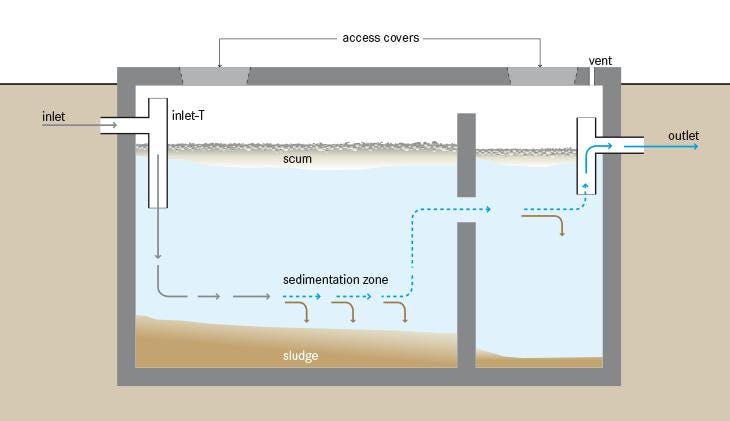The Main Principles Of Septic Tank Pumping
Wiki Article
The 45-Second Trick For Septic Tank Maintenance
Table of ContentsThe Best Guide To Septic ServiceThe 10-Minute Rule for Septic Tank PumpingThe smart Trick of Septic Service That Nobody is DiscussingSeptic Tank Pumping Things To Know Before You BuySeptic Tank Maintenance Things To Know Before You BuyA Biased View of Septic System InspectionThe 2-Minute Rule for Septic Tank MaintenanceHow Septic Tank Maintenance can Save You Time, Stress, and Money.
Excess sludge might overflow into the 2nd area, but it is avoided from escaping the container by a T-shaped outlet (Figure 2). To maintain the sludge from accumulating and triggering the system to fail, house owners are expected to get their sewage-disposal tanks pumped every three to five years, depending upon quantity of usage and also on-site soil problems.In a conventional septic system, effluent is released to a drainpipe field with pipes embedded in dug trenches that are loaded with clean, porous gravel, after that covered with landscaping fabric. Some drainpipe areas abandon trenches for a superficial drain area bed filled up with the exact same clean, porous crushed rock.
Some Known Details About Septic System Inspection
Read a lot more about different drainpipe fields on EPA's Types of Septic Solutions web page. Number 3. Instances of adjusted septic tank designs. Leading: Drip Distribution Septic Tank, with a drain field bed instead of dug trenches. Bottom: Pile Septic Tank, with stacked soil, sand, and crushed rock to boost the height of the drainpipe field.Current Use About 20% of homes in the United States depend on a decentralized wastewater system, according to EPA. Even more than 60 million people are serviced by septic tanks especially. Septic use differs extensively by area and state, with the highest focus at 55% of households in Vermont and also the least expensive at 10% of households in California.
The Only Guide to Septic Tank Emptying
That doesn't always happen. septic tank services. For some, it can be a (incorrect) factor of satisfaction to go ten, fifteen, even twenty years without having their systems pumped. This causes solids to construct up in the container, which leads them to overflow into the second area and also potentially out right into the drainpipe field, ultimately causing "failing".For septic treatment to work, there requires to be at the very least two feet of completely dry, unsaturated dirt beneath the drain field to filter the wastewater before it reaches the groundwater level and flows right into the groundwater. Without this buffer of completely dry soil, the septic tank can not efficiently carry the effluent to the drainpipe area, thus permitting nutrients as well as pathogens present in the wastewater to straight pollute groundwater and the surface area rivers it streams right into.
Septic Tank Installation Fundamentals Explained
Septic systems, as soon as set up, also have a tendency to be "hidden, out of mind" for lawmakers and regional regulating bodies. According to EPA, very few allowing firms perform routine assessments of septic systems after they are installed. This puts the onus onto property owners to ensure their septic tanks he has a good point are working as finest they can, as well as to watch out for indications that their system has stopped working.As soon as a system is set up, extremely few permitting companies carry out regular inspections of energetic septic systems to ensure they are still functioning properly. This puts the obligation on the house owner to maintain up with the necessary system upkeep as well as to look out for indicators of failing, like those noted below and later on in this short article.
Examine This Report on Septic Tank Pump Out
Drain systems are either divided right into stormwater sewage systems as well as hygienic drains, or combined right into a Incorporated Sewer Overflow that handles both stormwater as well as sanitary sewage or wastewater (although these are not recommended!). Wastewater that reaches the main plant is dealt with prior to being released right into the setting. septic tank pumping. Many counties as well as districts have actually efficiently made the button from septic to drain over the years.
The Best Guide To Septic Tank Emptying
Look for leaks in your faucets as well as commodes (guidelines on just how to inform if your toilet is leaking can be located below). Utilize your trash disposal sparingly; instead, try to capture and also accumulate food scraps from the drain and also compost them if possible - otherwise, throw them in the trash.Don't utilize any septic ingredients, particularly ones that declare to dissolve solids look at this web-site in the container to send out to the drainpipe field: that's the reverse of what we desire from a functioning septic system! Marlowe Starling. Marlowe Starling.
1. Septic tanks filter wastewater. Septic tanks are underground wastewater therapy frameworks. Typically, they are extra common in backwoods that do not have streamlined sewage system systems. Many septic tanks contain a container that gathers waste as well as a drainpipe area. The tank refines the wastewater, separating floatable issue (for instance oil) and solids.
Septic Tank Maintenance Things To Know Before You Get This
There are some things you can not place with the system. If you're on a central sewer system, you likely do not believe concerning what you send out through the system.Nonetheless, they likewise damage the bacteria that should aid the system job well. The weight of the vehicle can damage the water drainage pipelines and destroy your system. Know where your drain area is and maintain a map of it simply in instance. Some water-loving types of greenery, such as look at this website crying willows, can send origins right into the drainpipe area.
Report this wiki page